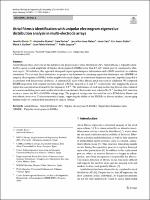Por favor, use este identificador para citar o enlazar este ítem:
https://repositorio.usj.es/handle/123456789/888
Registro completo de metadatos
| Campo DC | Valor | Lengua/Idioma |
|---|---|---|
| dc.contributor.author | Riccio, Jennifer | - |
| dc.contributor.author | Alcaine Otín, Alejandro | - |
| dc.contributor.author | Rocher, Sara | - |
| dc.contributor.author | Martinez-Mateu, Laura | - |
| dc.contributor.author | Laguna, Pablo | - |
| dc.contributor.author | Martinez, Juan Pablo | - |
| dc.contributor.author | Laguna, Pablo | - |
| dc.contributor.author | Saiz, Javier | - |
| dc.contributor.author | Guillem, Maria S | - |
| dc.contributor.author | Invers‑Rubio, Eric | - |
| dc.date.accessioned | 2023-01-09T11:47:20Z | - |
| dc.date.available | 2023-01-09T11:47:20Z | - |
| dc.date.issued | 2022-09-13 | - |
| dc.identifier.issn | 3091–3112 | en_US |
| dc.identifier.uri | https://repositorio.usj.es/handle/123456789/888 | - |
| dc.description.abstract | Atrial fibrosis plays a key role in the initiation and progression of atrial fibrillation (AF). Atrial fibrosis is typically identified by a peak-to-peak amplitude of bipolar electrograms (b-EGMs) lower than 0.5 mV, which may be considered as ablation targets. Nevertheless, this approach disregards signal spatiotemporal information and b-EGM sensitivity to catheter orientation. To overcome these limitations, we propose the dominant-to-remaining eigenvalue dominance ratio (EIGDR) of unipolar electrograms (u-EGMs) within neighbor electrode cliques as a waveform dispersion measure, hypothesizing that it is correlated with the presence of fibrosis. A simulated 2D tissue with a fibrosis patch was used for validation. We computed EIGDR maps from both original and time-aligned u-EGMs, denoted as R and RA , respectively, also mapping the gain in eigenvalue concentration obtained by the alignment, ΔRA . The performance of each map in detecting fibrosis was evaluated in scenarios including noise and variable electrode-tissue distance. Best results were achieved by RA , reaching 94% detection accuracy, versus the 86% of b-EGMs voltage maps. The proposed strategy was also tested in real u-EGMs from fibrotic and non-fibrotic areas over 3D electroanatomical maps, supporting the ability of the EIGDRs as fibrosis markers, encouraging further studies to confirm their translation to clinical settings | en_US |
| dc.format.extent | 22 p. | en_US |
| dc.format.mimetype | application/pdf | en_US |
| dc.language.iso | eng | en_US |
| dc.publisher | Springer | en_US |
| dc.relation.requires | adobe | en_US |
| dc.rights | Attribution-NonCommercial-NoDerivatives 4.0 Internacional | * |
| dc.rights.uri | http://creativecommons.org/licenses/by-nc-nd/4.0/ | * |
| dc.subject | Atrial fibrosis | en_US |
| dc.subject | Atrial fibrillation (AF) | en_US |
| dc.subject | Bipolar electrograms (b-EGMs) | en_US |
| dc.subject | Eigenvalue dominance ratio (EIGDR) | en_US |
| dc.subject | Unipolar electrograms (u-EGMs) | en_US |
| dc.title | Atrial fibrosis identification with unipolar electrogram eigenvalue distribution analysis in multi‑electrode arrays | en_US |
| dc.type | journal article | es_ES |
| dc.identifier.doi | https://doi.org/10.1007/s11517-022-02648-3 | en_US |
| dc.rights.accessRights | open access | es_ES |
| Aparece en las colecciones: | Artículos de revistas | |
Ficheros en este ítem:
| Fichero | Descripción | Tamaño | Formato | |
|---|---|---|---|---|
| Atrial fibrosis identification.pdf | 4 MB | Adobe PDF |  Visualizar/Abrir |
Este ítem está sujeto a una licencia Creative Commons Licencia Creative Commons

